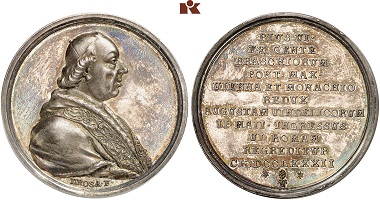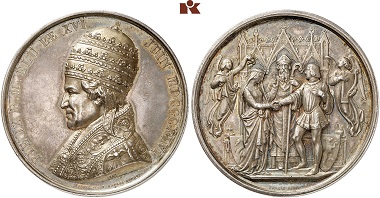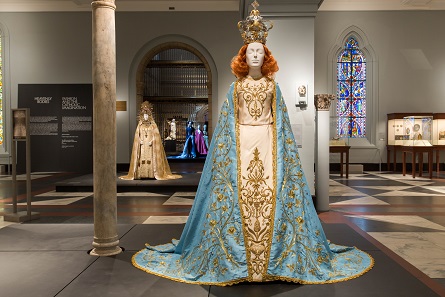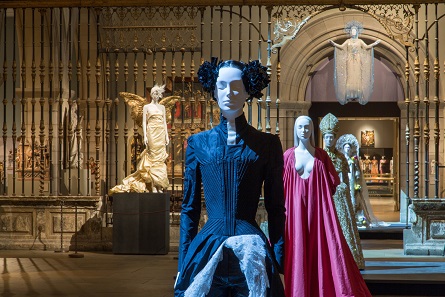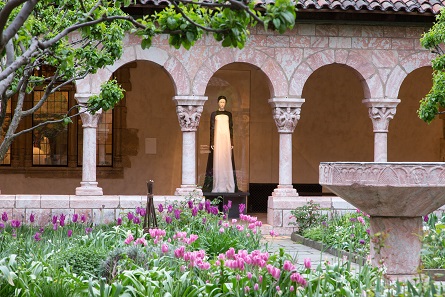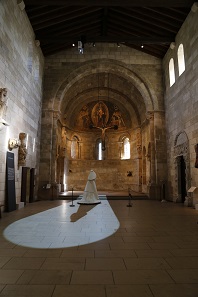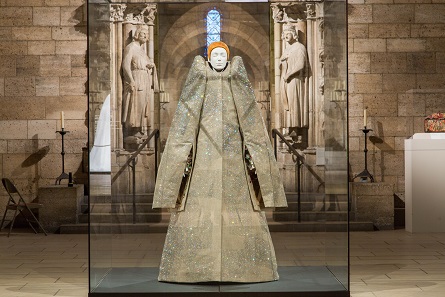July 12, 2018 – The Costume Institute’s Spring 2018 Exhibition “Heavenly Bodies: Fashion and the Catholic Imagination” at The Met Fifth Avenue and Met Cloisters focuses on Fashion and the Catholic Imagination. The thematic exhibition features a dialogue between fashion and masterworks of medieval art in The Met collection to examine fashion’s ongoing engagement with the devotional practices and traditions of Catholicism. A group of papal robes and accessories from the Vatican serves as the cornerstone of the exhibition, highlighting the enduring influence of liturgical vestments on designers.
Papal vestments and accessories like the tiara are often shown on numismatic items as these three specimens (not in the exhibition) show from the 18th to the 20th centuries: A silver medal from Augsburg made in 1782 to commemorate the visit of Pope Pius VI. From Künker auction 305 (2018), 2960.
A silver medal of Pope Pius IX from 1846/1846 on his accession to the throne. From Künker auction 305 (2018), 2191.
A bronze medal of Pope Pius VII from 1807. From Künker auction 305 (2018), 2960.
“The Catholic imagination is rooted in and sustained by artistic practice, and fashion’s embrace of sacred images, objects, and customs continues the ever-evolving relationship between art and religion,” said Daniel H. Weiss, President and CEO of The Met. “The Museum’s collection of Byzantine and western medieval art, in combination with the architecture and galleries that house these collections at The Met, provide the perfect context for these remarkable fashions.”
Gallery View, Mary and Michael Jaharis Galleries for Byzantine Art. © The Metropolitan Museum of Art.
“Fashion and religion have long been intertwined, mutually inspiring and informing one another,” said Andrew Bolton, Wendy Yu Curator in Charge of The Costume Institute. “Although this relationship has been complex and sometimes contested, it has produced some of the most inventive and innovative creations in the history of fashion.”
Gallery View, Medieval Europe Gallery. © The Metropolitan Museum of Art.
The exhibition features approximately 40 ecclesiastical masterworks from the Sistine Chapel sacristy, many of which have never been seen outside the Vatican. Encompassing more than 15 papacies from the 18th to the early 21st century, these masterworks are on view in the Anna Wintour Costume Center galleries and include papal vestments and accessories, such as rings and tiaras. The last time the Vatican sent a loan of this magnitude to The Met was in 1983, for The Vatican Collections exhibition, which is the Museum’s third most-visited show.
Gallery View, Medieval Sculpture Hall. © The Metropolitan Museum of Art.
Providing an interpretative context for fashion’s engagement with Catholicism are more than 150 ensembles, primarily womens wear, from the early 20th century to the present, on view in the Byzantine and medieval galleries, in part of the Robert Lehman Wing, and at The Met Cloisters alongside medieval art from The Met collection. The presentation situates these designs within the broader context of religious artistic production to analyze their connection to the historiography of material Christianity and their contribution to the construction of the Catholic imagination.
Gallery View, Cuxa Cloister. © The Metropolitan Museum of Art.
Designers in the exhibition include A. F. Vandevorst, Azzedine Alaïa, Cristobal Balenciaga, Geoffrey Beene, Marc Bohan (for House of Dior), Thom Browne, Roberto Capucci, Jean-Charles de Castelbajac, Gabrielle Chanel, Sorelle Fontana, Domenico Dolce and Stefano Gabbana (for Dolce & Gabbana), John Galliano (for House of Dior and his own label), Jean Paul Gaultier, Robert Goossens (for Chanel and Yves Saint Laurent), Craig Green, Madame Grès (Alix Barton), Demna Gvasalia (for Balenciaga), Rosella Jardini (for Moschino), Stephen Jones, Christian Lacroix, Karl Lagerfeld (for House of Chanel), Jeanne Lanvin, Shaun Leane, Henri Matisse, Claire McCardell, Laura and Kate Mulleavy (for Rodarte), Thierry Mugler, Rick Owens, Carli Pearson (for Cimone), Maria Grazia Chiuri and Pierpaolo Piccioli (for Valentino), Pierpaolo Piccioli (for Valentino), Stefano Pilati (for Saint Laurent), Gareth Pugh, Yves Saint Laurent, Elsa Schiaparelli, Raf Simons (for his own label and House of Dior), Viktor Horsting and Rolf Snoeren (for Viktor & Rolf), Olivier Theyskens, Riccardo Tisci, Jun Takahashi (for Undercover), Thea Bregazzi and Justin Thornton (for Preen), Philip Treacy, Duke Fulco di Verdura (for Gabrielle Chanel), Donatella Versace (for Versace), Gianni Versace, and Valentina.
Gallery View, Fuentiduena Chapel. © The Metropolitan Museum of Art.
A publication by Mr. Bolton accompanies the exhibition and includes texts by Ms. Boehm, Mr. Mann, and Marzia Cataldi Gallo, David Morgan, Gianfranco Cardinal Ravasi, and David Tracy in addition to new images by Katerina Jebb. Published by The Metropolitan Museum of Art and distributed by Yale University Press, the 336-page hardcover book has 330 illustrations. The two-volume set comes in a slipcase and retails for $65.
Gallery View, Romanesque Hall. © The Metropolitan Museum of Art.
The exhibition runs until October 8, 2018 and is on view at The Met Fifth Avenue – in the medieval galleries, Mary and Michael Jaharis Galleries for Byzantine Art, part of The Robert Lehman Wing, and the Anna Wintour Costume Center –and uptown at The Met Cloisters. The exhibition is made possible by Christine and Stephen A. Schwarzman, and Versace. Additional support is provided by Condé Nast.
Further information and images are available from the exhibition page on the Met website.




